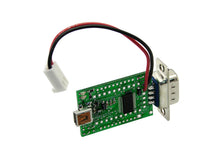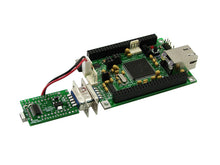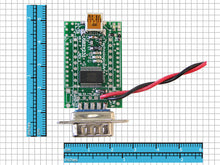This module provides USB-to-RS232 conversion, plus USB power breakout to supply your target board. As a bonus, a 3.3V regulator is included so you can power 5V or 3V targets!
Features:
- USB-to-RS232 translation of TX, RX, and DTR signals
- on-board 3.3V regulator
- jumper-selectable option for powering target via 5V or 3.3V
- activity LEDs provided for RX and TX monitoring
- 500mA polyfuse protects host computer's USB port from accidental shorts
- flying leads with two-pin polarized Molex connector
- DB9P connector plugs into any target board having DB9S
- small footprint (approx. 1.0x2.0 inches; 25x51 mm)
Your target board can draw up to 500mA from a USB port on your computer; less, if it is plugged into a hub.
Resources
Schematic diagram for this module is available from http://support.technologicalarts.com/docs/USB%20Boards/. Hardwired to Configuration 1) shown on schematic.
Drivers for the FT232R USB chip used in this design are available from www.ftdichip.com
Technological Arts boards (Adapt9S12, etc.) can be powered directly by plugging the power cable into J1, with the following caveats:
1) if the target board has a 5V regulator, you'll need to bypass it
2) if the target board has a 3V regulator, no modification is required
3) if the target board and attached circuits draw more than 500 mA, the polyfuse on the USB232 will activate, shutting down the 5V supply until the current draw is reduced






